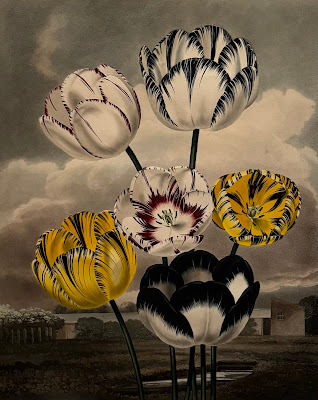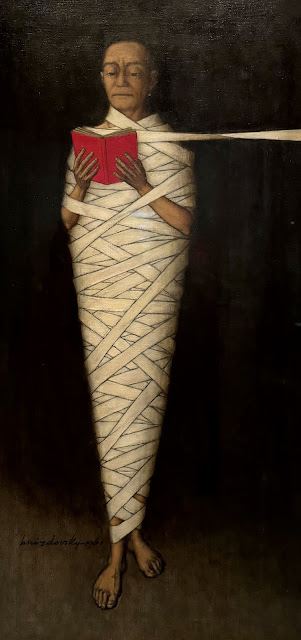I resisted the New York Public Library's "Treasures" exhibit because I once worked there and figured I'd seen most of them. Absolutely wrong. New intellectual goodies have emerged as both the times and I have changed. This early 20th-century magazine for readers who believed in racial equality, women's suffrage and civil liberties also gave aspiring and politically committed artists like Carlo Leonetti a platform for their illustrations. Call it "come hither" socialism!
Ukrainian-born artist Jacques Hnizdovsky fled Europe for the Bronx during World War II. "Man Reading," or "Man Liberated by Books," painted in 1961, almost seems naive in the context of Putin's brutal invasion.
Albrecht Dürer built his "Triumphal Arch," commissioned by Emperor Maximilian in 1799, from more 200 woodblock prints. Easily portable, this monumental if one-dimensional work of royal propaganda, alludes to his lineage, lands and accomplishments as it fills an entire, eight-foot-tall display case.
Charles Dickens composed much of Hard Times--and many of his more than 15,000 letters--at this Victorian desk.
America's whitewashing of its early history is clearly evident in a 1770 depiction of an event that kicked off the Revolutionary War. The engraver changed the skin color of the first person killed in the Boston Massacre, Crispus Attucks (at left), a whaler of African and Native American descent. A century later, Northern abolitionists restored his blackness and used the print--appropriated by Paul Revere!-- as more inclusive evidence of the nation's diverse origins.
Victor Green, a postal worker in New Jersey, and his wife Alma, who migrated north from Virginia, created a travel guide that enabled Black travelers on road and rail trips to find food and safe lodging from 1936 to 1966, two years after the passage of the Civil Rights Act. It inspired the Academy of Motion Picture Arts & Sciences controversial choice for Best Picture in 2019.
In the mid-19th century, Sequoyah created the ABC's of the Cherokee language which previously only had been spoken.
In 1975, Milton Glaser "eased on down the road" this tornado-like graphic for The Wiz, an all-Black musical adaptation of The Wizard of Oz. I would have liked to see it paired with one of W.W. Denslow's illustrations for L. Frank Baum's book, which I remember vividly from childhood.
Irene Sharaff outfitted the Jets and the Sharks for the original Broadway production of West Side Story in 1957. Materials like these are appropriately housed in the Library for the Performing Arts at Lincoln Center.
By the mid-19th century, color had been seeping into printed illustration, first by hand and then mechanically. Dogs in those days impersonated their masters more often than they played poker.
 |
| "Premier Janvier" by François Séraphin Delpech (1821) |
 |
| Tulips from "The Beauties of Flora" (artist unknown, 1820) |
Faith Ringgold created this story quilt to honor African American creativity for hanging at the Library's Schomburg Center for Research in Black Culture. I was responsible for publicizing the dedication of the collection's new building--now a Harlem landmark--and exhibitions when I worked for NYPL in the early 1980s.
The Library added these prints long after I left. I doubt if Elizabeth Roth, the "keeper" of the collection during my tenure, would have approved. Swiss-born, prim and very proper, she wore a single strand of pearls to work nearly every day. You knew she was about to deliver a zinger when she clutched them during a conversation.
 |
| "Knitting the Wind" by Maria Berrio (2016) |
 |
| "Rose Tattoo" from "Arcade" by Alison Saar (2000) |
Check out the panoramic view of New York City taken during the construction of the Brooklyn Bridge in this video.
The New York World's Fair in 1939 promoted the future, introducing television and air conditioning to consumers. It left behind landmarks still visible in Flushing Meadows today.
But you'll have to travel to Riverhead to ride one of the Long Island Railroad's customized trains.
Twenty-something Jacob Lawrence painted this New York subway scene in 1938, shortly before completing the Migration Series, inspired in part by his parent's journey from the rural south to Atlantic City where he was born. By the time Lawrence was twelve, he and his mother had moved to Harlem.
The East Village Eye, a cheap monthly magazine published from 1979 to 1987, punched way above its weight documenting the influential art and music scene in a neighborhood now known around the world.
Speaking of eyes, look what I found staring out of a Schiaparelli window at Bergdorf Goodman on my way home from the library.















No comments:
Post a Comment